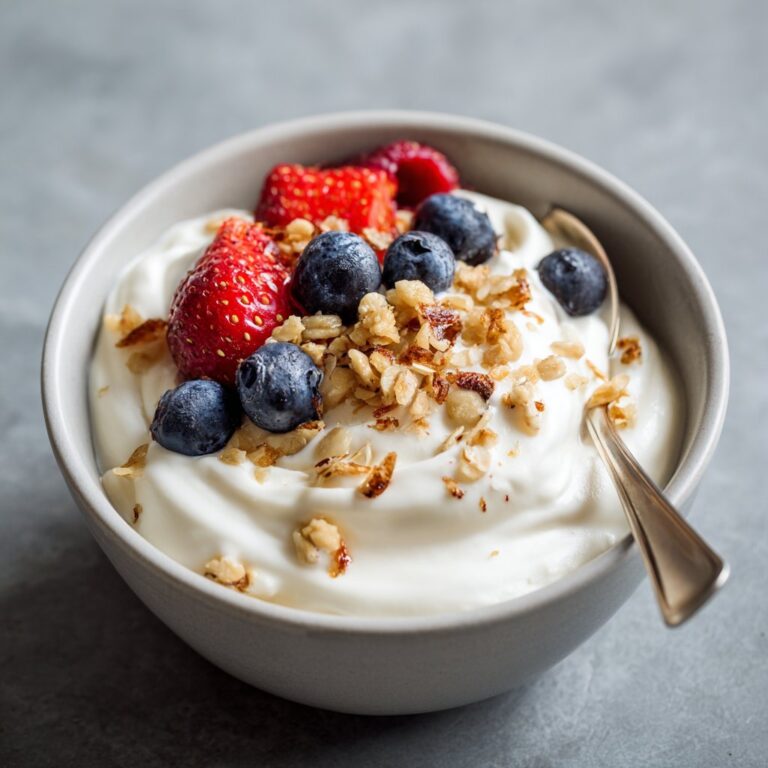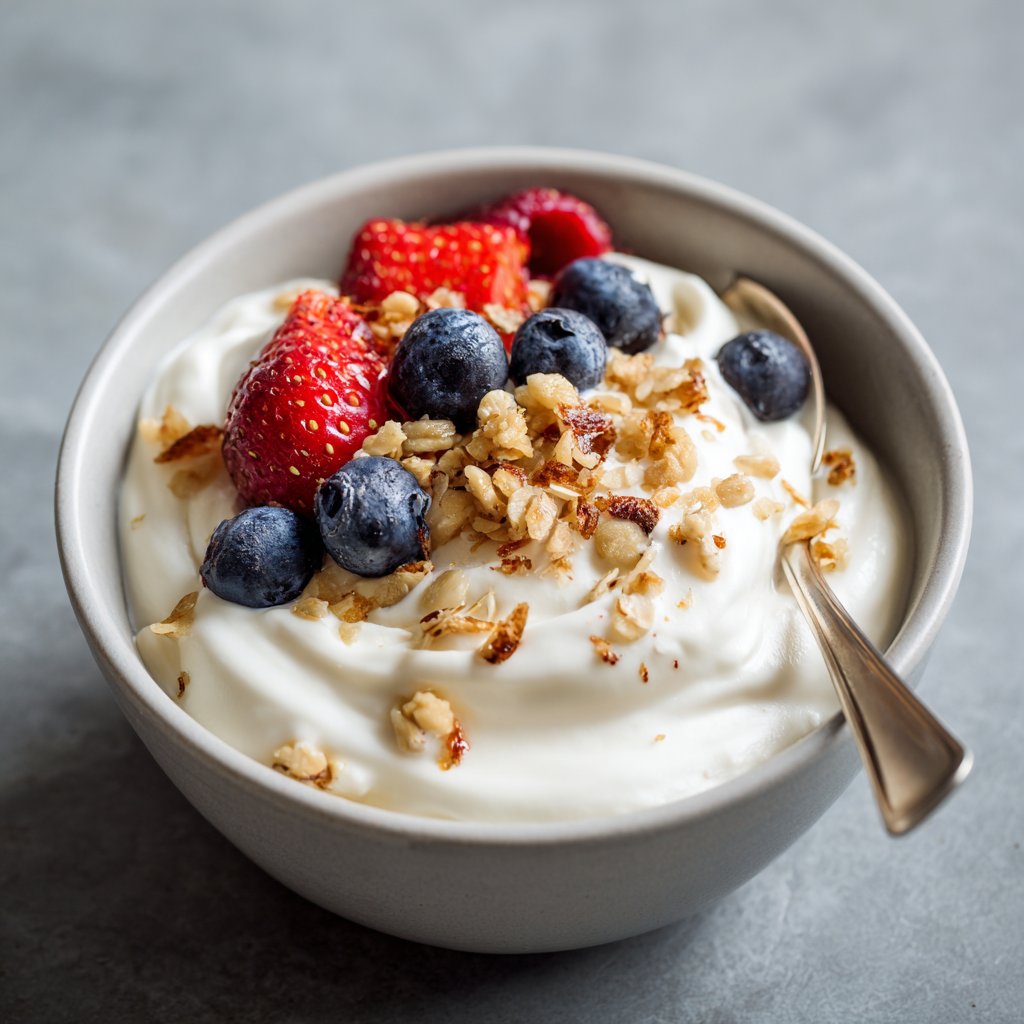Protein-Packed Greek Yogurt has become a staple for health enthusiasts worldwide, thanks to its rich, creamy texture, high protein content, and versatility. This traditional dairy product originates from Greece, where it has been consumed for centuries as both a meal and an ingredient in various recipes.
Today, Greek yogurt stands out for its thick consistency, achieved by straining out most of the whey, resulting in a snack that is not only satisfying but also boasts a higher protein concentration than regular yogurt.
As busy lifestyles demand quick yet nutritious options, Protein-Packed Greek Yogurt has soared in popularity for breakfast, post-workout snacks, and even as a healthy dessert alternative.
Its benefits stretch well beyond taste – Greek yogurt is also a great source of calcium, probiotics, and essential vitamins, making it an excellent choice for supporting gut health and bone strength.
For more on the origins and nutrition of Greek yogurt, visit Healthline’s comprehensive guide at https://www.healthline.com/nutrition/greek-yogurt-benefits. Whether you want to fuel your morning or recover after exercise, learning how to make Protein-Packed Greek Yogurt at home will help you control the ingredients, customize the flavors, and save money without sacrificing quality.
Ingredients for Protein-Packed Greek Yogurt
- 4 cups whole milk (can substitute with 2% or skim for lower fat)
- 2 tablespoons plain Greek yogurt (with live active cultures, for starter)
- Optional: 1 scoop unflavored whey protein powder
- Optional: 1-2 tablespoons honey or maple syrup
- Optional toppings: fresh berries, sliced nuts, chia seeds, granola
Instructions for Making Protein-Packed Greek Yogurt
- Pour the milk into a heavy-bottomed saucepan and heat over medium heat until it reaches 180°F (82°C), stirring occasionally to prevent scorching.
- Remove the saucepan from the heat and allow the milk to cool to 110°F (43°C).
- In a small bowl, mix the Greek yogurt starter with a few tablespoons of the cooled milk until smooth.
- Gently whisk the yogurt mixture back into the cooled milk.
- Pour the mixture into a clean container or glass bowl, cover with a lid or plastic wrap, and place in a warm, draft-free spot (like an oven with the light on or a yogurt maker) for 6-12 hours to allow fermentation.
- Check the consistency after 6 hours; for a tangier, thicker yogurt, let it ferment up to 12 hours.
- After fermentation, line a fine-mesh sieve or colander with cheesecloth and set it over a large bowl.
- Pour the yogurt into the lined sieve and let it strain in the refrigerator for 2-4 hours until thick and creamy.
- Transfer the strained yogurt to a bowl and whisk in the protein powder (if using) until fully dissolved and smooth.
- Sweeten with honey or maple syrup if desired, and top with your choice of fresh berries, nuts, or other toppings before serving.
Nutritional Information
Protein-Packed Greek Yogurt is renowned for its high protein content, making it a standout choice for those looking to boost their daily protein intake in a delicious and convenient form.
Each serving of homemade Greek yogurt (about 1 cup) made with whole milk contains approximately 20 grams of protein, 7 grams of fat, 8 grams of carbohydrates, and 140 calories.
If you add a scoop of unflavored whey protein powder, the protein content can increase by an additional 20-25 grams per serving, making it an ideal option for athletes, fitness enthusiasts, or anyone seeking a satiating snack.
Greek yogurt is also an excellent source of calcium, providing around 20% of your daily needs, as well as probiotics, which help support a healthy gut microbiome. Choosing to make it at home allows you to control the sugar content and avoid unnecessary additives often found in store-bought varieties.
For an in-depth breakdown of Greek yogurt’s nutritional profile and health benefits, check out the USDA’s FoodData Central at https://fdc.nal.usda.gov/fdc-app.html#/food-details/173401/nutrients. The versatility of this Protein-Packed Greek Yogurt recipe means you can adjust the fat and calorie levels by choosing different types of milk and additions, making it suitable for various dietary needs.
Wine/Beverage Pairings With Protein-Packed Greek Yogurt
Protein-Packed Greek Yogurt pairs beautifully with a range of beverages, depending on the time of day and your personal preferences. For breakfast or a refreshing snack, pair it with a freshly brewed green tea or a glass of cold-pressed juice, such as orange or carrot.
These beverages complement the tanginess of the yogurt and provide a burst of antioxidants and vitamins. If you’re enjoying Greek yogurt as a light dessert, consider serving it with a sparkling water infused with lemon or mint for a palate-cleansing finish.
For a more indulgent treat, a well-chilled glass of Moscato d’Asti or a light Riesling wine will highlight the creamy, slightly tart flavors of the yogurt.
Coffee lovers might enjoy pairing their Protein-Packed Greek Yogurt with an iced coffee or a smooth latte, making for a protein-rich, energizing start to the day. Herbal teas, especially those with floral or citrus notes, also work harmoniously with the subtle flavors of the yogurt.
Cooking Tips and Variations
To achieve the best results when preparing Protein-Packed Greek Yogurt at home, start with the freshest milk you can find. Whole milk yields the creamiest texture, but you can opt for 2% or skim milk for a lower-fat version.
For an extra protein boost, add a scoop of unflavored whey or plant-based protein powder after straining, ensuring you whisk thoroughly to prevent lumps. If you’re new to yogurt making, invest in a good-quality thermometer to monitor the milk’s temperature accurately, as this is crucial for successful fermentation.
For those who prefer a non-dairy option, use soy or almond milk with a dairy-free yogurt starter, but note that the consistency and protein content may vary. Customize your Protein-Packed Greek Yogurt with a range of mix-ins like cacao nibs, seeds, or dried fruit.
If you prefer a sweeter flavor, add a drizzle of honey or maple syrup, or stir in vanilla extract. For a thicker Greek yogurt, extend the straining time, or use a double layer of cheesecloth. Leftover whey from straining can be used in smoothies, soups, or even baking.
Remember to reserve a few tablespoons of each batch as a starter culture for your next batch, keeping your yogurt-making cycle sustainable.
Serving Suggestions
Protein-Packed Greek Yogurt is a versatile dish that can be enjoyed in countless ways. For a nourishing breakfast, serve it in a bowl topped with a medley of fresh seasonal fruits, such as strawberries, blueberries, or kiwi, and sprinkle with crunchy granola or nuts for added texture and nutrition.
If you’re looking to make a protein-rich snack, portion the yogurt into individual jars or containers for a grab-and-go option, perfect for busy mornings or post-gym fuel.
For an elegant brunch presentation, layer the Greek yogurt with fruit compote and a drizzle of honey in parfait glasses, creating a visually appealing and delicious treat.
Athletes and active individuals can blend the yogurt into smoothies or recovery bowls, adding banana, spinach, or nut butter for an extra nutrient boost.
Protein-Packed Greek Yogurt also makes an excellent base for savory dips – simply stir in chopped herbs, lemon juice, and a touch of garlic to create a creamy spread for vegetables or whole-grain crackers.
For dessert, try serving the yogurt with a dusting of cinnamon and a few dark chocolate shavings. Its thick texture and mild tang make it a delightful canvas for both sweet and savory creations, ensuring there is always a way to enjoy this protein powerhouse.

Protein-Packed Greek Yogurt Health Benefits
Protein-Packed Greek Yogurt offers a wide array of health benefits, making it an excellent addition to any balanced diet. Its high protein content helps promote satiety, support muscle repair, and maintain lean body mass, which is especially beneficial for athletes and individuals aiming to manage their weight.
The live active cultures found in Greek yogurt offer probiotic benefits that support digestive health and boost immune function. Additionally, Greek yogurt is a rich source of calcium, crucial for bone strength and density, as well as important B vitamins that contribute to energy metabolism.
For those seeking to limit sugar intake, homemade Greek yogurt allows you to control added sweeteners, keeping your snack wholesome and nourishing. Its versatility means it can easily fit into vegetarian, low-carb, or Mediterranean-style diets.
Studies have also shown that regular consumption of fermented dairy products like Greek yogurt may help reduce the risk of type 2 diabetes and cardiovascular disease. For more information on the health impacts of dairy and yogurt, visit the Mayo Clinic’s nutrition resources at https://www.mayoclinic.org/healthy-lifestyle/nutrition-and-healthy-eating/expert-answers/yogurt/faq-20058197.
FAQs About Protein-Packed Greek Yogurt
How much protein is in Protein-Packed Greek Yogurt?
Homemade Protein-Packed Greek Yogurt typically contains around 20 grams of protein per cup, with the option to increase this by adding protein powder.
Can I make Protein-Packed Greek Yogurt with plant-based milk?
Yes, you can use soy or almond milk with a dairy-free yogurt starter, but the texture and protein content will differ from traditional Greek yogurt.
How long does homemade Greek yogurt last in the refrigerator?
Properly stored in an airtight container, homemade Greek yogurt will keep in the refrigerator for up to 7-10 days.
What can I do with leftover whey from straining?
Leftover whey can be used in smoothies, baking, soups, or as a liquid replacement in pancake batter to add extra protein and nutrients.
Do I need special equipment to make Protein-Packed Greek Yogurt?
While a yogurt maker is convenient, you can make Greek yogurt with basic kitchen equipment such as a saucepan, thermometer, and fine-mesh sieve with cheesecloth.
Protein-Packed Greek Yogurt is a delicious, nutrient-rich addition to any meal plan, offering a satisfying balance of creamy texture, tangy flavor, and impressive protein content. Making it at home not only allows you to customize flavor and ingredients but also ensures you enjoy the freshest, most wholesome yogurt possible. Whether you enjoy it as a hearty breakfast, a post-workout snack, or a healthy dessert, this versatile dish is an excellent way to boost your protein intake and support overall well-being. Embrace the tradition of Greek yogurt in your kitchen and discover the difference homemade makes.
Ingredients
- 2 cups plain non-fat Greek yogurt
- 1 scoop vanilla protein powder
- 1/2 cup fresh mixed berries (strawberries, blueberries, raspberries)
- 2 tablespoons chopped almonds
- 1 tablespoon chia seeds
- 1 tablespoon honey
- 1/4 teaspoon ground cinnamon
- 1 tablespoon pumpkin seeds
Instructions
-
1In a medium bowl, combine the Greek yogurt and vanilla protein powder. Stir until smooth and well mixed.
-
2Divide the yogurt mixture evenly between two serving bowls.
-
3Top each bowl with fresh mixed berries, chopped almonds, chia seeds, and pumpkin seeds.
-
4Drizzle honey over the top and sprinkle with ground cinnamon.
-
5Serve immediately and enjoy your protein-packed Greek yogurt.
Approximate Information for One Serving
Nutrition Disclaimers
Number of total servings shown is approximate. Actual number of servings will depend on your preferred portion sizes.
Nutritional values shown are general guidelines and reflect information for 1 serving using the ingredients listed, not including any optional ingredients. Actual macros may vary slightly depending on specific brands and types of ingredients used.
To determine the weight of one serving, prepare the recipe as instructed. Weigh the finished recipe, then divide the weight of the finished recipe (not including the weight of the container the food is in) by the desired number of servings. Result will be the weight of one serving.
Did you make this recipe?
Please consider Pinning it!!






